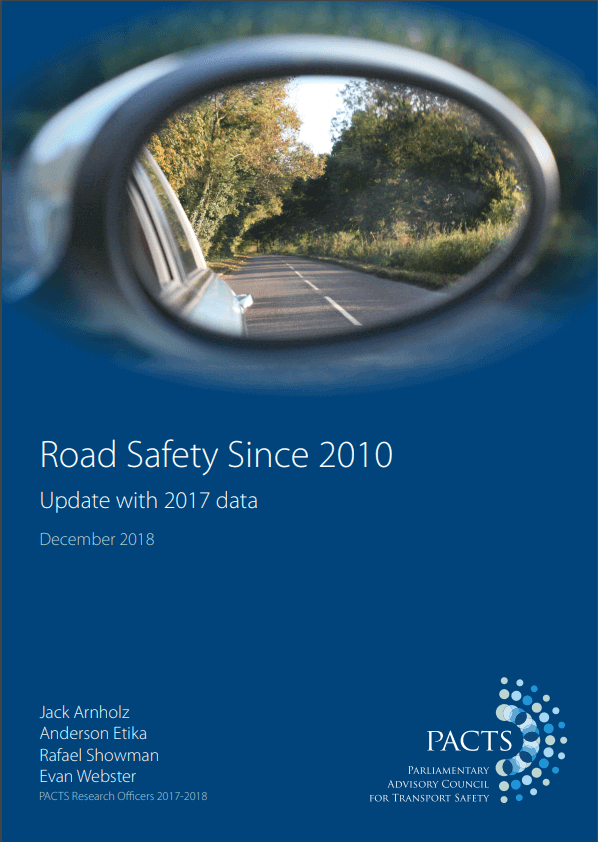Road Safety Since 2010 – Update with 2017 data
“PACTS understands that the DfT is putting the final touches to its refreshed Road Safety Statement and Action Plan. PACTS very much hopes that all these announcements will focus on what matters and what works. To keep the focus on the big picture – reducing the number of the most serious road casualties – we are publishing Road Safety Since 2010. This updates our earlier report with the latest (2017) casualty data.” said David Davies, Executive Director, PACTS.
“This short, factual report confirms the lack of progress in reducing deaths on UK roads over the past seven years. Uniquely, it compares the trends, on common bases, across the main jurisdictions of the UK (England, London, Scotland, Wales and Northern Ireland) and for the Strategic Road Network in England. It also compares casualty trends for the main road user groups. It shows that concerted national action is required by the UK government and devolved authorities to get UK road safety back on track.”
Please click the graphic below for the report in full.
This report shows:
· UK road deaths in 2017 were substantially (37%) lower than in the period 2005-09. This ranges from 33% lower in Wales to 47% lower in Scotland. This is almost entirely due to the unusual reductions during the economic recession of 2007-2010, particularly in 2010.
· There has been virtually no progress since 2010. Compared with 2010, UK road deaths in 2017 were only 3% lower. Only Scotland has achieved a significant reduction since 2010, and this is heavily dependent on the figure for 2017. Because the annual number of deaths in each
jurisdiction except England is relatively small – around 100 – the percentage change can fluctuate considerably from year to year.
· Taking population growth into account, the number of road deaths per head of population declined by 8% for the UK between 2010 and 2017. This means that, from an individual’s perspective, the risk of a fatal road injury has reduced.
· The UK has managed to maintain its position as one of the best performing European countries, measured by road deaths per million population, despite having one of the lowest percentage rates of reduction in deaths since 2010. It remains close to Sweden, although Norway and
Switzerland now consistently perform better.
· All major road user groups have seen substantial reductions in deaths when compared to 2005-09. Apart from pedestrians, all groups also saw modest reductions between 2010 and 2017.
· Because of changes to the systems used by some police forces to record road casualties since 2015, only trends in road deaths can be compared reliably.
Although the UK Government has refused to adopt national road safety targets, many parts of the UK have done so. Scotland, Wales and Northern Ireland adopted targets earlier and used a 2004-08 baseline. These countries are making good progress and some targets have been achieved
already.
London and Highways England have targets based on 2005-09. Although only one year later, inclusion of the year 2009 in this baseline and removal of 2004 make the targets much more challenging. It is widely accepted that targets have helped to drive road safety effort in these
jurisdictions and that progress would have been less without the targets. However, the casualty figures do not demonstrate differential progress as a result of having targets.
Based on this analysis, PACTS makes the following recommendations:
· The Government needs to take bold measures, at national level, to end the “plateau” in the number of deaths and seriously injured casualties since 2010 across most of the UK;
· The Government should not refer to substantial reductions in road casualties “over the past 10 years” without also stating that there has been almost no reduction in deaths or serious injuries since 2010;
· Those jurisdictions that have already achieved, or almost achieved, their 2020 road safety targets should renew them as soon as possible. New targets should have baseline and deadline periods that each cover at least three years. For example, achieving a 50% reduction in fatalities by 2028-30 (average) compared to the 2018-2020 (average);
· Separate targets should be adopted for deaths and for seriously injured casualties
· Those police forces which have not yet adopted the new casualty reporting system (CRASH)
are urged to do so.

